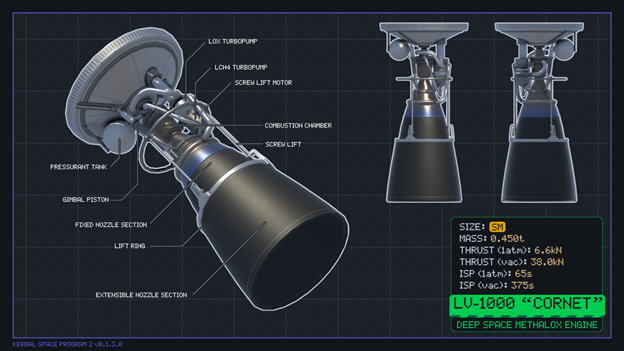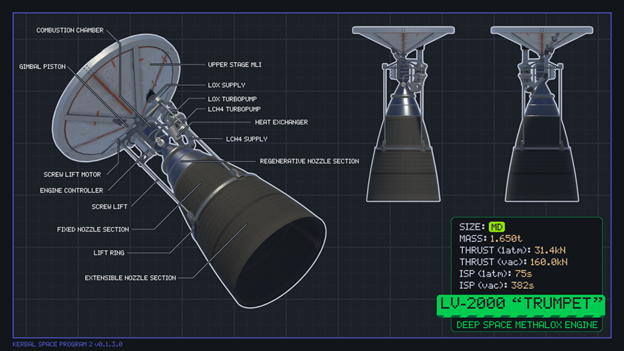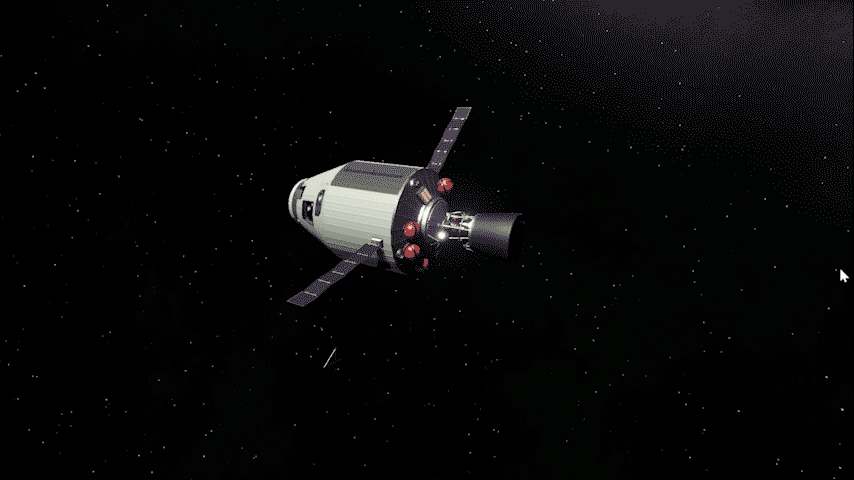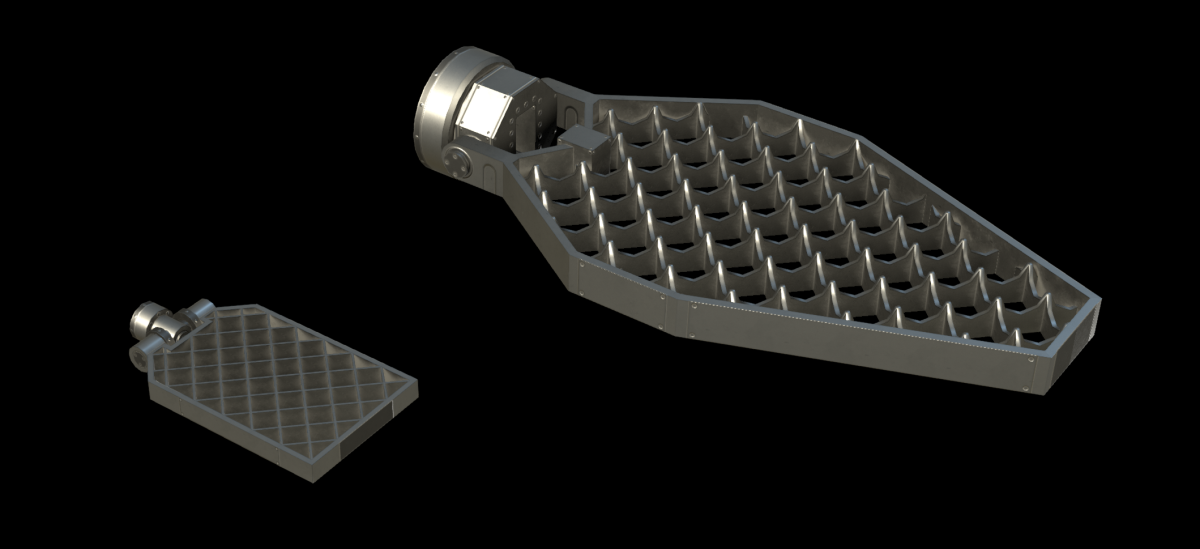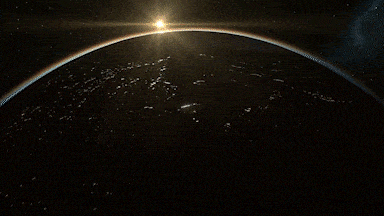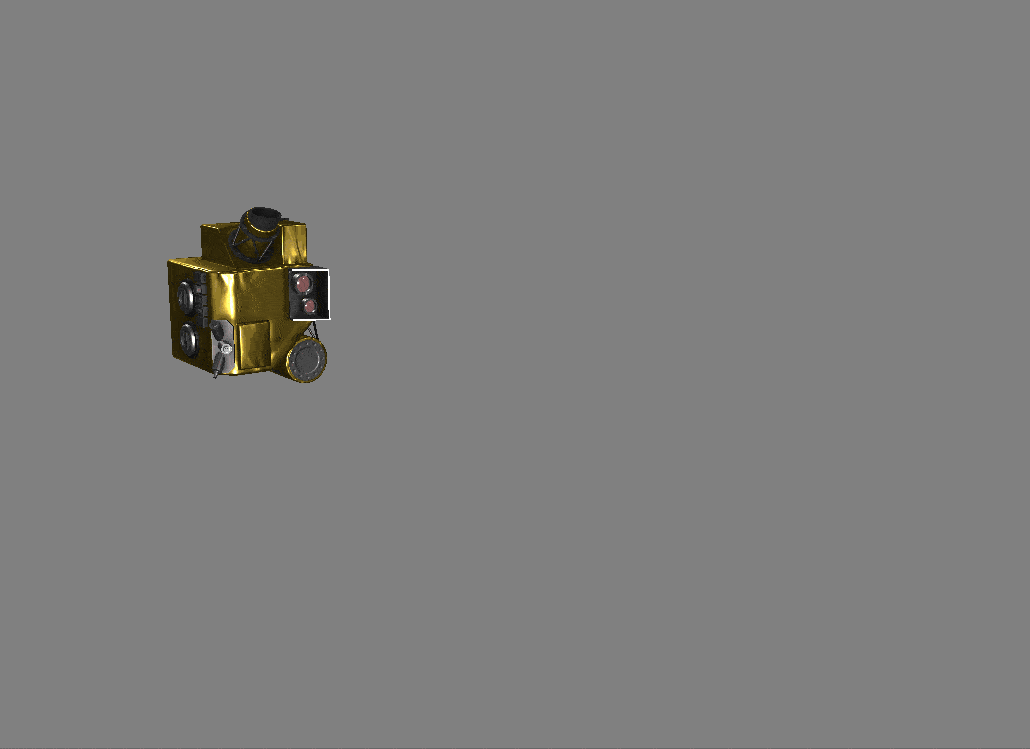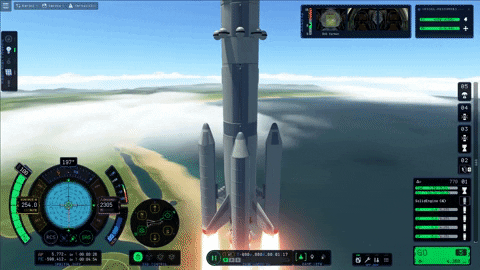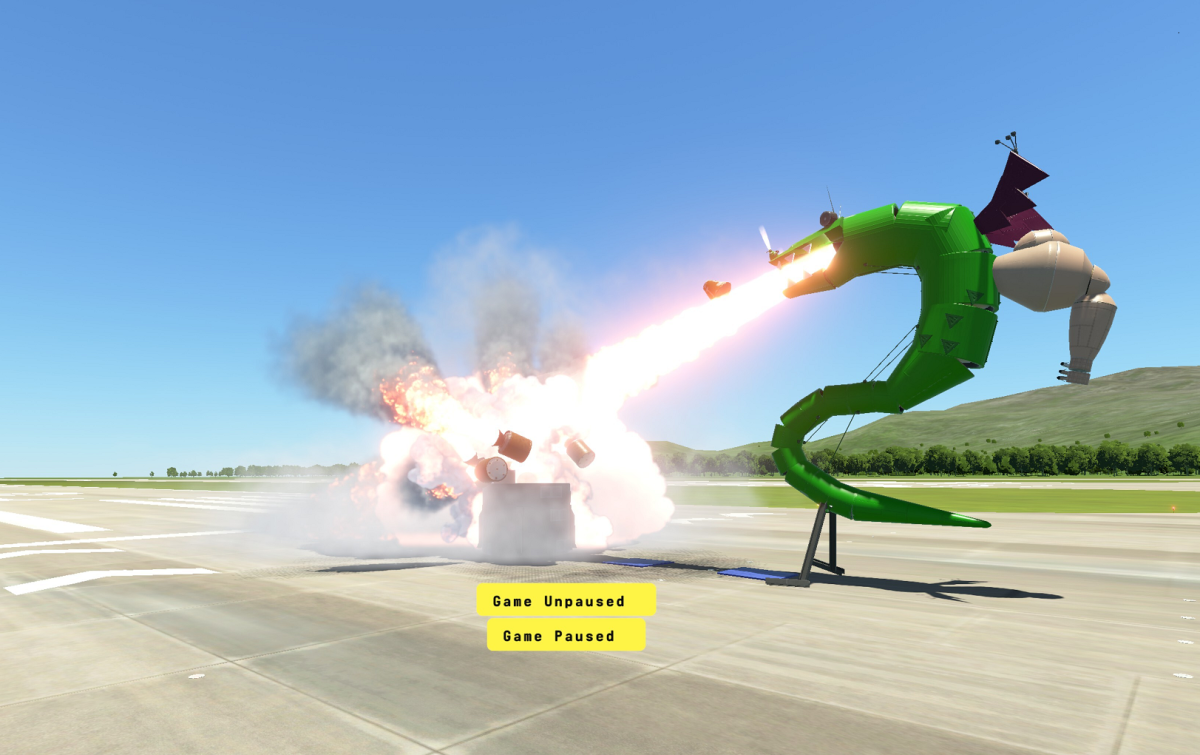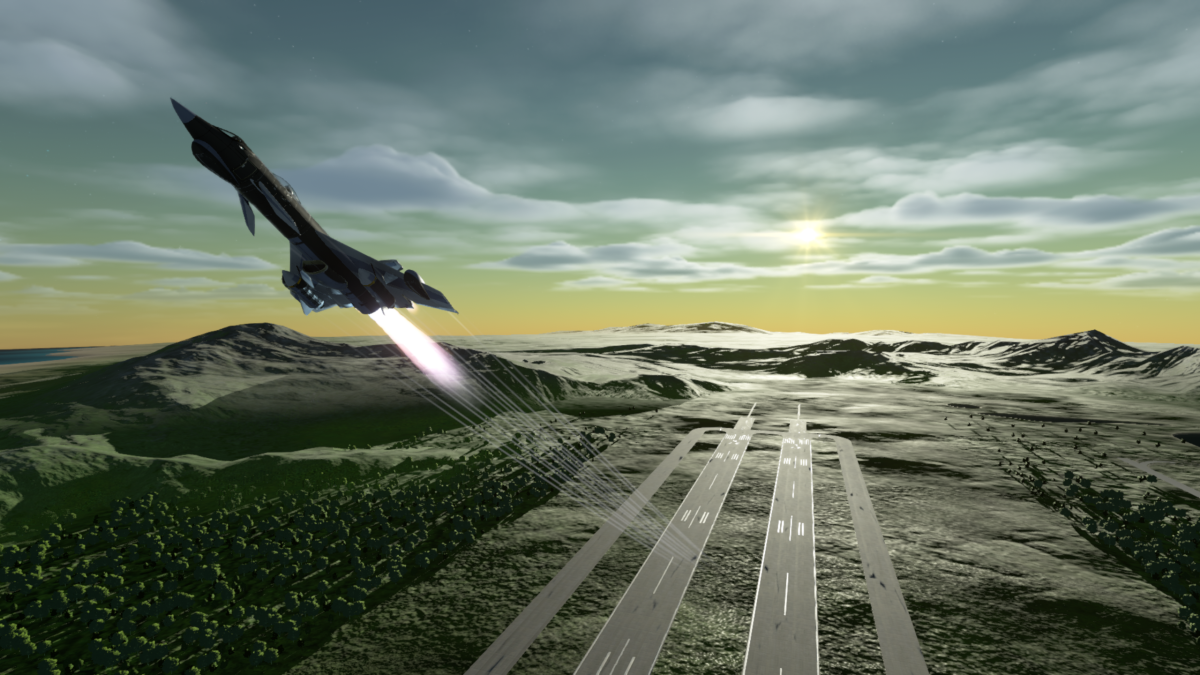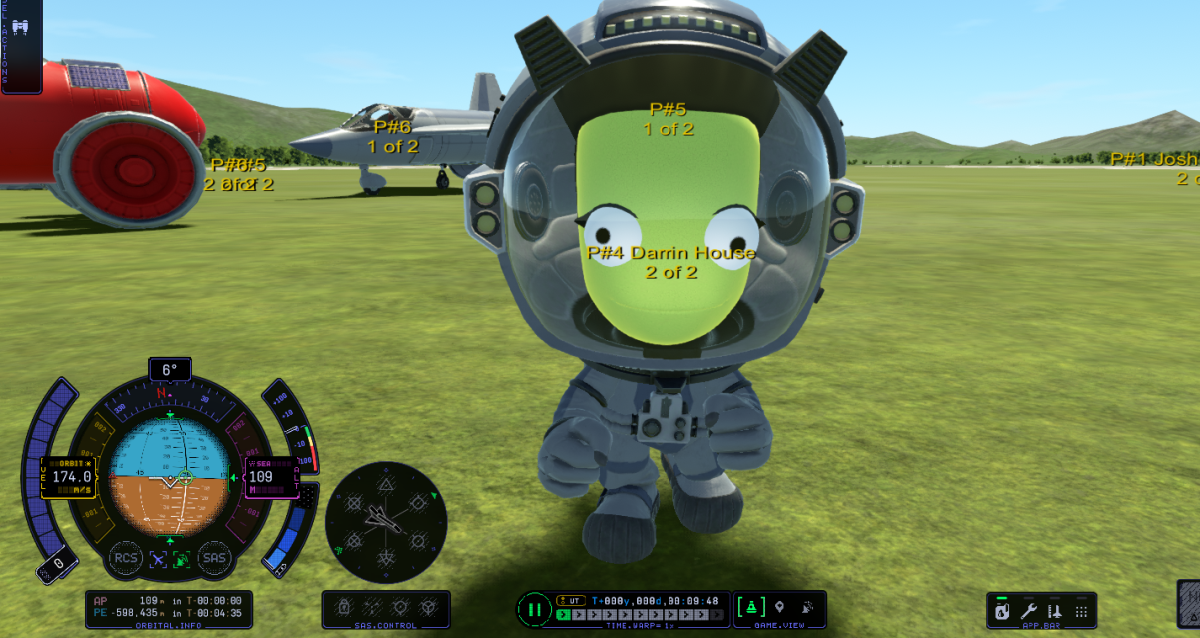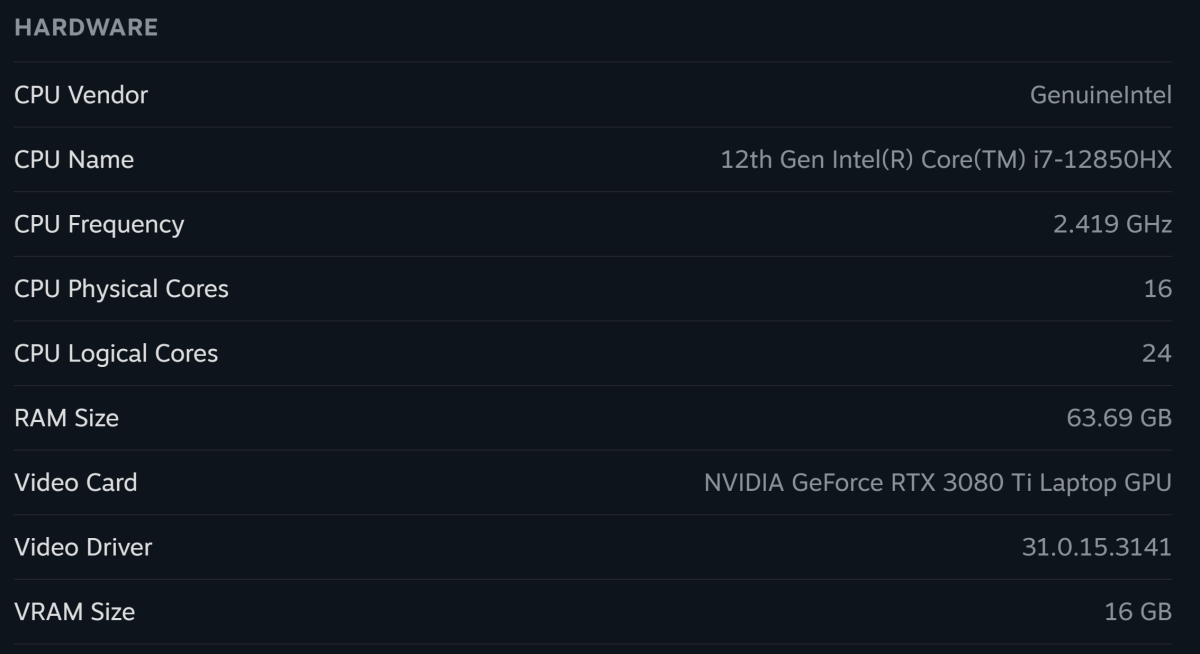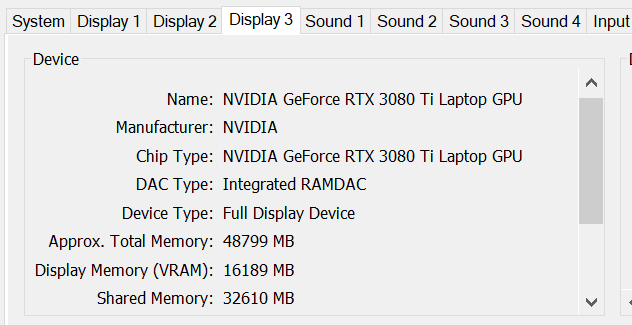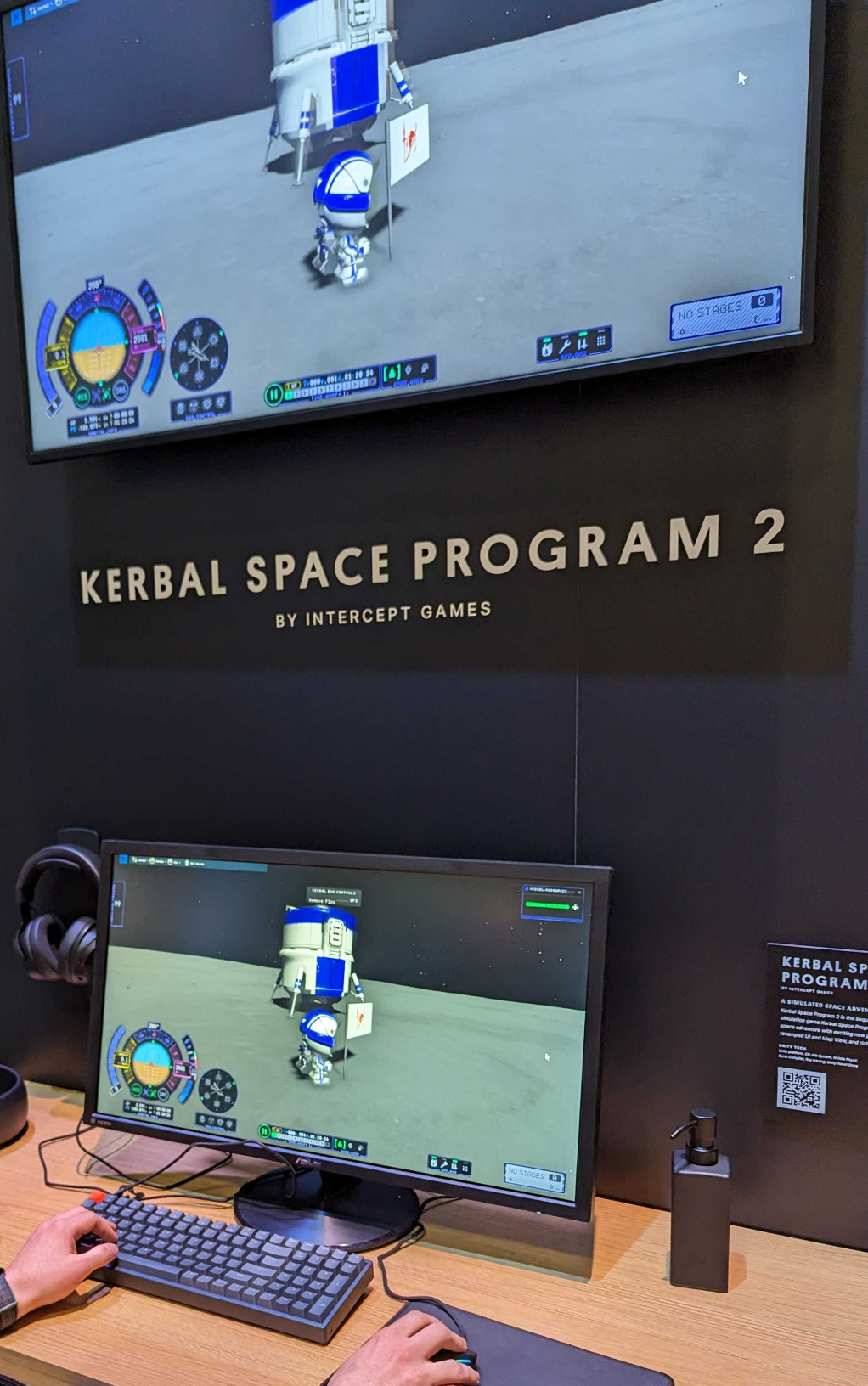
Jun 22, 2023
Kerbal Space Program 2 - mikey
🚀 <-- This rocket denotes an issue or change that community members directly helped by sharing or suggesting it to our dev team. Thanks to all of you who send in bug reports and suggestions!
Bug Fixes
Flight & Map
- Added ability to toggle visibility of some 3D map elements
- Added multi-joint system for wings that places a scalable array of four joints along the length of the wing root
- Added new IVA Kerbal animation to show reaction to and recovery from non-catastrophic impact events
- Added player setting to allow toggling of Navball in Map view
- Added settings for toggling tooltips and for setting default throttle
- Fixed: Activating or staging an engine causes decouplers and fairing shrouds below that engine to stage
- Fixed: Brake activation applies to multiple vessels simultaneously after undocking
- Fixed: Camera drifts away from recently-decoupled vehicles
- Fixed: Changes made to landing gear friction level settings in the VAB do not propagate to flight
- Fixed: Countdown does not pause when time warp is paused
- Fixed: Gantry positioning code produces errant event registrations
- Fixed: Imprecise cloud shadow masking causes aura when shadow appears behind vehicle
- Fixed: In-cockpit Kerbals sometimes show T-pose due to corrupted fidget animations
- 🚀 Fixed: Inline drag calculations use incorrect facing directions when calculating cross sectional area https://forum.kerbalspaceprogram.com/topic/213954-massive-drag-bug-with-basically-every-inline-auxiliary-part-tests-results-and-pictures/
- Fixed: XM-G50 Radial Air Intake intake drag cube oriented incorrectly
- 🚀 Fixed: Instances of decoupled sections remain linked when decoupling a non-command root part that is separated from a command part by an engine mount https://forum.kerbalspaceprogram.com/topic/216916-root-part-below-an-engineplate-and-decoupler-causes-major-issues-for-a-craft/
- Fixed: Kerbal flag-planting and flag object animation de-synchronize when time-warp is used
- 🚀 Fixed: Landed EVA Kerbals disappear when a vehicle time warps into their physics range
- Fixed: Inactive crash course warning is fired when vehicle is placed on the launchpad or when player returns to KSC from flight
- Fixed: Inactive crash course warning occurs when a Kerbal performs EVA at the launchpad
- Fixed: Landed vehicles cause torrent of VesselLandedAtRest spam
- Fixed: Launch gantry does not adjust position to accommodate wide vehicles on launchpad
- 🚀 Fixed: Launching "Jumping Flea" vehicle causes null states https://forum.kerbalspaceprogram.com/topic/216998-stock-flea-launched-from-launchpad-1-unlaunchable-with-silent-flames-shooting-out-of-the-engine/
- Fixed: NaN displayed in the drag/lift ratio value
- Fixed: NRE errors occur when parts get destroyed
- Fixed: Out of Electricity message event fails to trigger when EC depleted
- Fixed: Some docking ports fail to release when undocking
- Fixed: Structural tubes don't occlude aerodynamic drag
- Fixed: Strut joint is misclassified as "lingering" and automatically destroyed when loaded to launchpad
- 🚀 Fixed: Symmetrically-attached radial decouplers eject with different forces https://forum.kerbalspaceprogram.com/topic/216760-decouplers-are-applying-force-in-the-wrong-directions-causing-ruds-and-jettison-issues/
- Fixed: Thermal indicator generates log spam
- Fixed: Undocking docking port destroys vehicle if it has wheels or wings attached to it
- 🚀 Fixed: Undocking vehicle sections that are connected with struts fails to detach struts https://forum.kerbalspaceprogram.com/topic/215561-undocking-doesn%E2%80%99t-disconnect-struts/
- Fixed: Ground parts remain attached to the main assembly when their parent part is destroyed
- Fixed: Vehicle falls through terrain when returning it to focus after launching another vehicle outside its physics range
- 🚀 Fixed: Vehicle teleports inside Kerbin when partial fuel depletion event triggers during time-warp https://forum.kerbalspaceprogram.com/topic/217165-in-the-center-of-kerbol/
- Fixed: When loading a second vehicle to launchpad after first vehicle has been destroyed, launch button shows "No Stages" and is not clickable
- Fixed: Wingtip vortices display incorrectly due to incorrect case handling for contextual events
- Planetshine adjusted to improve reflected lighting on vehicles above the Mun, Minmus, and Eeloo
EVA
- Adjusted over-reflectivity of Kerbal eye materials
- Fixed: "Bobus" ladder does not provide seamless transition to adjacent ladders
- Fixed: Bill's and Bob's eyes have incorrect symmetry and color settings https://forum.kerbalspaceprogram.com/topic/213215-jeb-bill-and-bob-too-what-is-wrong-with-their-eyes/
- Fixed: Placeholder notification text displayed when Kerbal performs an EVA
- 🚀 Fixed: Time warp keyboard shortcuts are still active when typing in details for planted flags https://forum.kerbalspaceprogram.com/topic/214995-punctuation-in-flag-description-passes-to-time-warp-controls/ https://forum.kerbalspaceprogram.com/topic/212894-regular-keybindings-not-disabled-when-entering-text-when-planting-flag/ https://forum.kerbalspaceprogram.com/topic/215071-typing-while-editing-the-content-of-the-planted-flag-doesnt-lock-other-controls-outside-of-the-textbox-and-numbers-cannot-be-inputted/ [4]
Optimizations
- Added new compute kernel to improve terrain performance by reducing rendering of non-visible detail
- Optimized cloud shader algorithm to improve GPU performance
- Implemented job system to handle per-part water detection (for 150 part vehicle, CPU time reduced from 10ms to 1.5ms)
- Optimized and improved quality of lens flares by using a commandbuffer
- Optimized cloud rendering when camera is below cloud layer
- Optimized GPU and memory usage for water rendering by using stencil buffers and new shaders
- Optimized KSC instancing to reduce draw calls
- Optimized Part Manager by removing several layout groups
- Optimized per-engine point lights by turning off shadows
- Optimized PQS terrain textures to reduce memory usage
- Optimized rendering of 3D UI elements in VAB and flight
- Optimized scatter object performance by using more compact scatter spawn buffers to reduce GPU memory usage
- Optimized tesselation factor for medium and low quality water to improve GPU performance
- Optimized water tesselation factor for water viewed from high altitude
- Optimized runtime CPU performance for water rendering by updating some properties less than once per frame
- Reduced GPU memory used by local space shader by 75%
- Reduced low and medium quality cloud texture sizes for Kerbin, Duna, Eve, and Laythe
- Removed unnecessary logging for time warp interpolation
- Updated Eve's shorelines to reduce visual blockiness and improve CPU and memory usage
- Fixed: Cloud shadows are broken on Eve
- Fixed: Clouds have dark edges
- Fixed: Memory leaks triggered by loading saved games, loading tutorials, and reverting to VAB
- Fixed: The game crashes when attempting to view the EULA and Privacy Policy in Russian https://forum.kerbalspaceprogram.com/topic/217638-the-game-freezes-at-the-stage-of-accepting-the-license-agreement
- Fixed: Trees vanish before they are completely off-screen
- Fixed: Scatter objects render at first level of detail at all distances
Saving & Loading
- 🚀 Fixed: TravelLog Manager causes runaway save file inflation https://forum.kerbalspaceprogram.com/topic/213186-save-files-becoming-extremely-huge/
- Fixed: Vehicle spawns beneath terrain when loading saved game with EVA Kerbal in focus
- Fixed: Interstage fairing size does not persist correctly when loading a workspace
- Fixed: After launching a vessel, loading into a different game save with a flight in progress, and then reverting to the VAB, an incorrect vehicle from another game save is loaded
- Fixed: Descriptions disappear when making new workspace save from a stock vehicle workspace
- Fixed: Log fills with autosave spam
- Fixed: Autosave cooldown timers don't trigger
- Fixed: Thumbnails for saved games sometimes incorrectly display transparency
Parts & Stock Vessels
- Added A.I.R.B.R.A.K.E.S part
- Added Clamp-O-Tron Inline Docking Port, Clamp-O-Tron Shielded Docking Port, and Mk2 Clamp-O-Tron Docking Port parts
- Added Cornet, Trumpet, and Tuba engine parts
- Added S3-28800 Methalox fuel tank part
- Adjusted MEM-125 Engine Mount color mask and part size to match similar parts
- Added auto switching for multi-mode engines like the Rapier
- "Sustainer" descriptor added to appropriate engine subtitles
- Increased breaking force for wings, control surfaces, and stabilizers
- Methane engines are now surface-attachable
- Fixed: RTC "Rottweiler" truck chassis has incorrectly-oriented stack attach node and low texture resolution
- Fixed: "Statistics" header not properly localized in VAB
- Fixed: Air intake parts display unnecessary sliders in VAB Part Manager
- Fixed: Gimbal animation code causes log spam
- Fixed: Intake air listed as a transferrable resource in the Resource Manager
- Fixed: Mesh for SRB-KD25k "Kickback" Solid Fuel Booster is 7.5 degrees from correct rotation
- Fixed: Non-convex collision mesh for RF-AD 2000 Mk3 to Mk2 Methalox Adapter causes error message
- Fixed: Small nosecone base diameter does not match small stack parts
- Fixed: Stack node position on Mk1 "Explorer" Command Pod slightly misaligned
UI / UX
- 🚀 Added flight HUD UI scaling in player settings
- 🚀 Added player-controllable splash screen bypass ability
- Added description to the "Tab Away Audio" player setting
- Added notification when F5 is used to quicksave
- Added player setting to toggle visibility of Vessel/Object labels
- Added stock vessel filter to KSC launchpad menu
- Game View UI element is hidden when there is no active vessel
- Updated section names in input settings
- Updated settings menu user interface
- Updated UI for VAB header, launch assembly icon, fairing construction icons, procedural editing icon, fairing visibility icon, and root part icon
- Enabled configuration of unique spawn points for tutorial dialogs for each tutorial lesson
- Fixed: Code error in main menu when trying to access a deleted object
- Fixed: Implementation of localized File Date/Time is incorrect for regional formatting
- Fixed: In some languages, incorrect capitalization used in text for Pause Menu options
- Fixed: In wing editor, text has incorrect linebreak in some languages
- Fixed: Insufficient campaign save window height causes text overlap
- Fixed: Large values in the Tracking Station's Celestial Body Information panel are too long due to absence of large-magnitude unit conversions
- Fixed: Launchpad location button selection state does not change when deselected
- Fixed: Normal/anti-normal markers on Navball don't match SAS icons
- Fixed: Not possible to re-bind "E" key in input settings/controls
- Fixed: Part info tooltip text overlaps in some languages
- Fixed: Part tooltip appears behind part icon
- Fixed: Passive notifications remain visible when UI is toggled off using F2 https://forum.kerbalspaceprogram.com/topic/216500-f2-issues-pause-game-pop-up-still-visible-and-stage-scroll-bar-still-visible/
- Fixed: Stage numbering reverses after switching focus between decoupled vehicles
- Fixed: Staging stack drop line indicators appear in the middle of stages instead of between them
- 🚀 Fixed: Text layout for burn timer does not accommodate long text https://forum.kerbalspaceprogram.com/topic/216781-new-burn-timer-displays-time-incorrectly-when-the-node-is-above-99-days/
- Fixed: Trip planner layout does not allow longer localized text
- Fixed: Users cannot back out of the Privacy Policy window after exiting to the Main Menu from gameplay
- Fixed: VAB part module text extends beyond info panel bounds in some cases
- Fixed: When an vehicle is destroyed via the object picker in Tracking Station, parent celestial body list entry does not close
Construction
- 🚀 Fixed: Fairing editor button stays on the cursor when moving fairing in the VAB https://forum.kerbalspaceprogram.com/topic/216881-vab-fairing-editor-prevents-dragdrop-options/ https://forum.kerbalspaceprogram.com/topic/216434-cannot-let-go-of-a-part-in-vab-because-the-cursor-is-on-the-wrench-icon/
- 🚀 Fixed: Fairings don't properly get out of the way in the VAB internal/exploded mode https://forum.kerbalspaceprogram.com/topic/213001-trying-to-look-inside-fairings-visual-glitch
- Fixed: Fairing length slider gets stuck after reverting to the VAB from flight
- Fixed: Lower stage Delta-V displays 0 when adding an empty stage above an engine in the VAB
- Fixed: Changing radial symmetry count after placing the first part of a strut causes the strut to break
Fixed: Log error in some situations when selecting the visibility mode icon on an interstage fairing - 🚀 Fixed: Toggling control surface in wing editor fails to remove control surface when editing multiple wings
- Fixed: VAB becomes unresponsive after clicking the fairing edit button and doing an unrelated action
- Fixed: When holding ALT and hovering over part in the VAB, part asset name shows instead of part name
- Fixed: Wrench icon appears before placement of procedural wing
Environments
- Adjusted PQS transition range for Vall
- Integrated KSC trees into mesh scatter system, reducing lines of code and improving performance
- Added level of detail to aviation lights at KSC
- 🚀 Fixed: Some lights have missing textures when viewed at KSC https://forum.kerbalspaceprogram.com/topic/216413-ksc-lights-and-windows-appear-pink/
FX & Audio
- Adjusted VFX for launch clamps
- Adjusted VFX positioning for procedural engine plate shrouds and interstage fairings
- Fixed: Log spam every frame when air intake makes contact with the ground
- Replaced raycast-based lens flare occlusion with depth-based occlusion
- Added pixel-count solution to correlate lens flare intensity with nearest star's visible area
- Updated VFX for stack separators and decouplers
Tutorials
- Enabled dragging tutorial windows by headers
- Fixed: Fail state dialog does not properly display when failing some tutorials
- Fixed: Feature image for "Orbital Transfers" tutorial is incorrect
- Fixed: Player-adjusted position of tutorial message box does not persist
- Fixed: Subtitles missing from various sections of Orbits are Weird tutorial
Localization
- Fixed: "Go" button text field too small for some translated text
- Fixed: Bold text illegible in some Asian languages
- Fixed: For some languages, anti-aliasing settings have incorrect localization
- Fixed: For some languages, non-localized celestial body name appears on SOI entry
- Fixed: In some languages, "Fly Safe" placeholder vehicle name not translated
- Fixed: Incorrect word order on burn timer UI
- Fixed: Localization missing from Kerbal EVA controls window
- Fixed: Orientation cube text obscures 3D vehicle icon in some languages
- Fixed: Pre-made vehicle information in Save/Load window is incorrectly localized
- Fixed: Some text in Settings menu not localized
- Fixed: Part description for HFT ""Spherotron"" Hydrogen Fuel Tank not localized"
- Fixed: The Enter Text text box for the Campaign Name is displayed in English while creating a new game in a foreign language
- Fixed: The Velocity tab's 'Target' text is not translated when observed in any language other than English
- Fixed: Tutorial dialogues have minor bugs in some languages
- Fixed: Unlocalized strings appear in staging stack
Modding
- Fixed: LoadByLabel not properly respecting assets in addressables in mod asset bundles. Labelled addressables should load properly now
Submitting Bug Reports and Feedback
If you'd like to provide feedback about this build, there are many different ways to do so:Submit Feedback through the Game Launcher
Suggest a Change on the KSP Forums
Join us on Discord to Discuss Potential Changes
Bug reports should be shared to either:
Private Division Customer Support (for game-breaking bugs)
Dedicated Bug Reports on the KSP Subforum





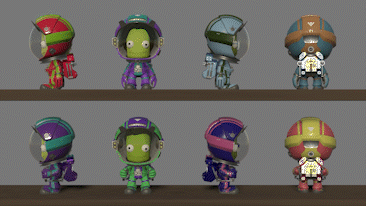
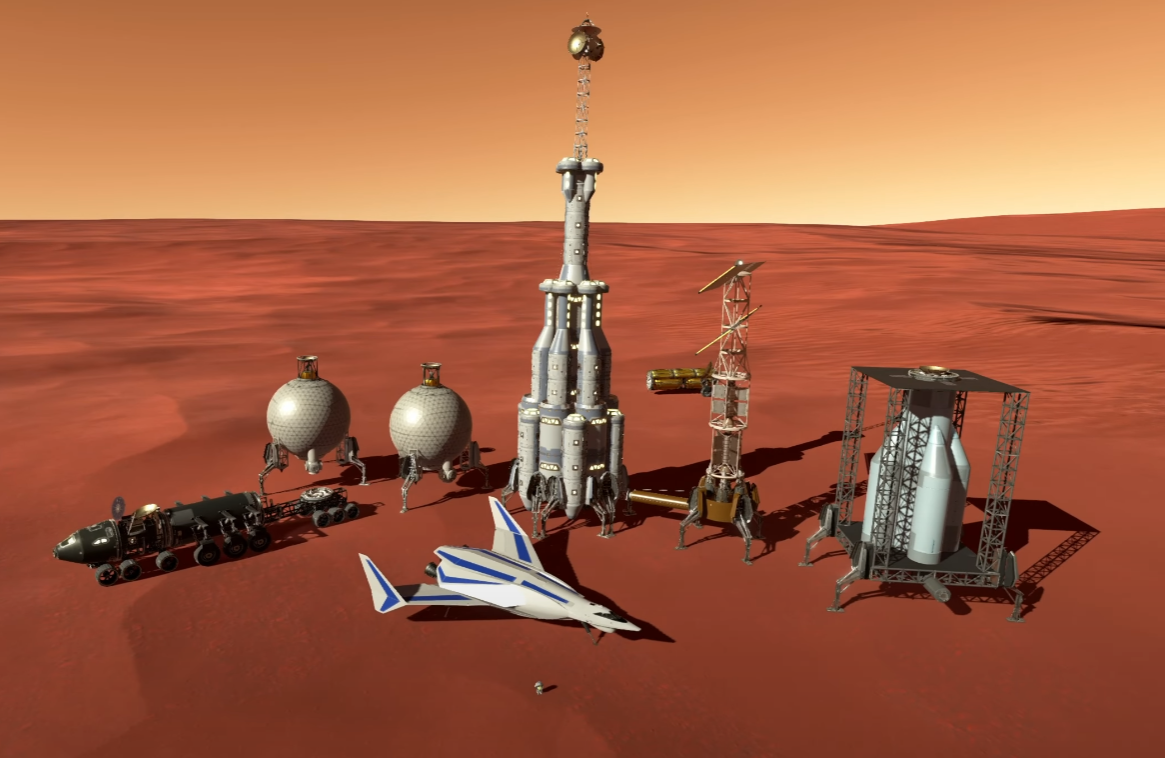
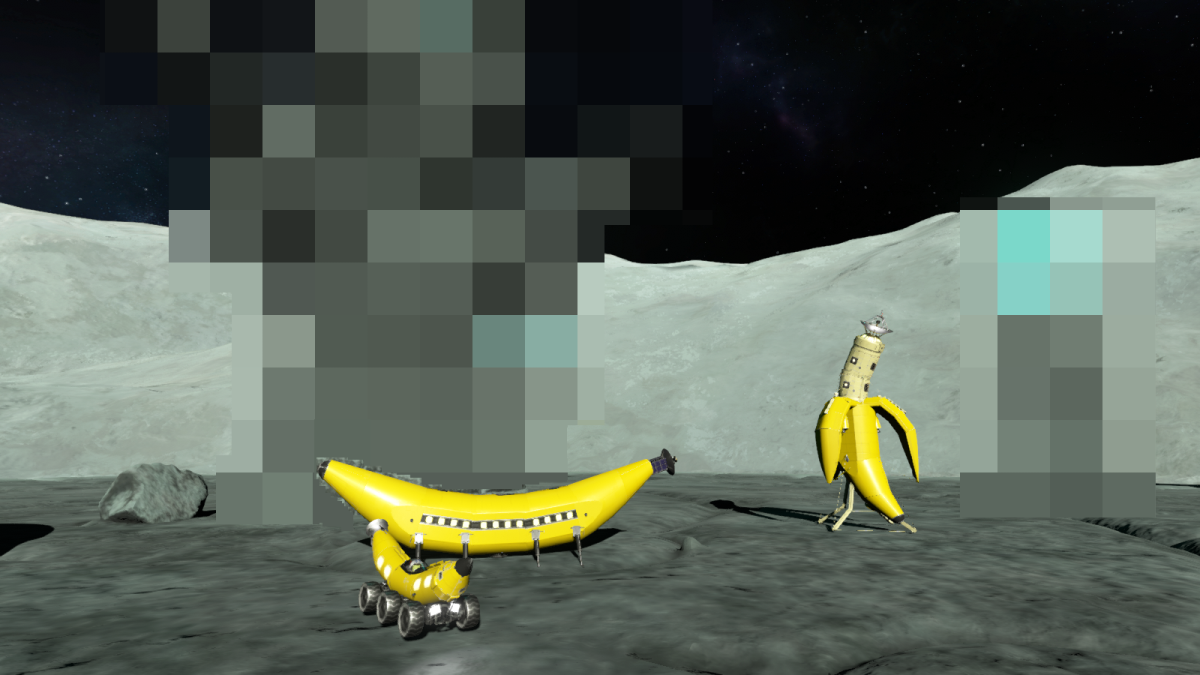
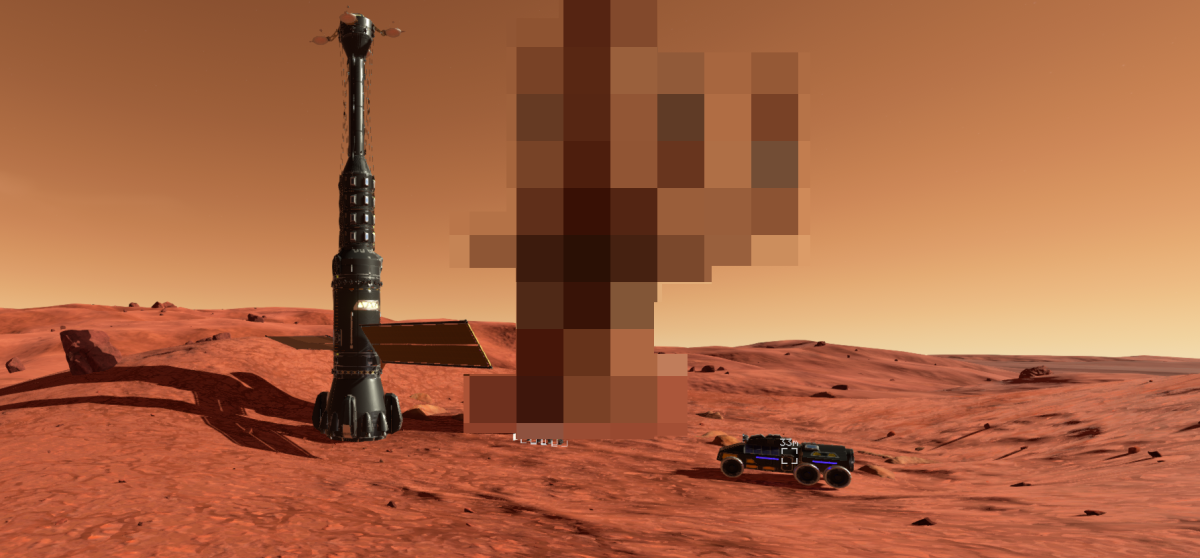

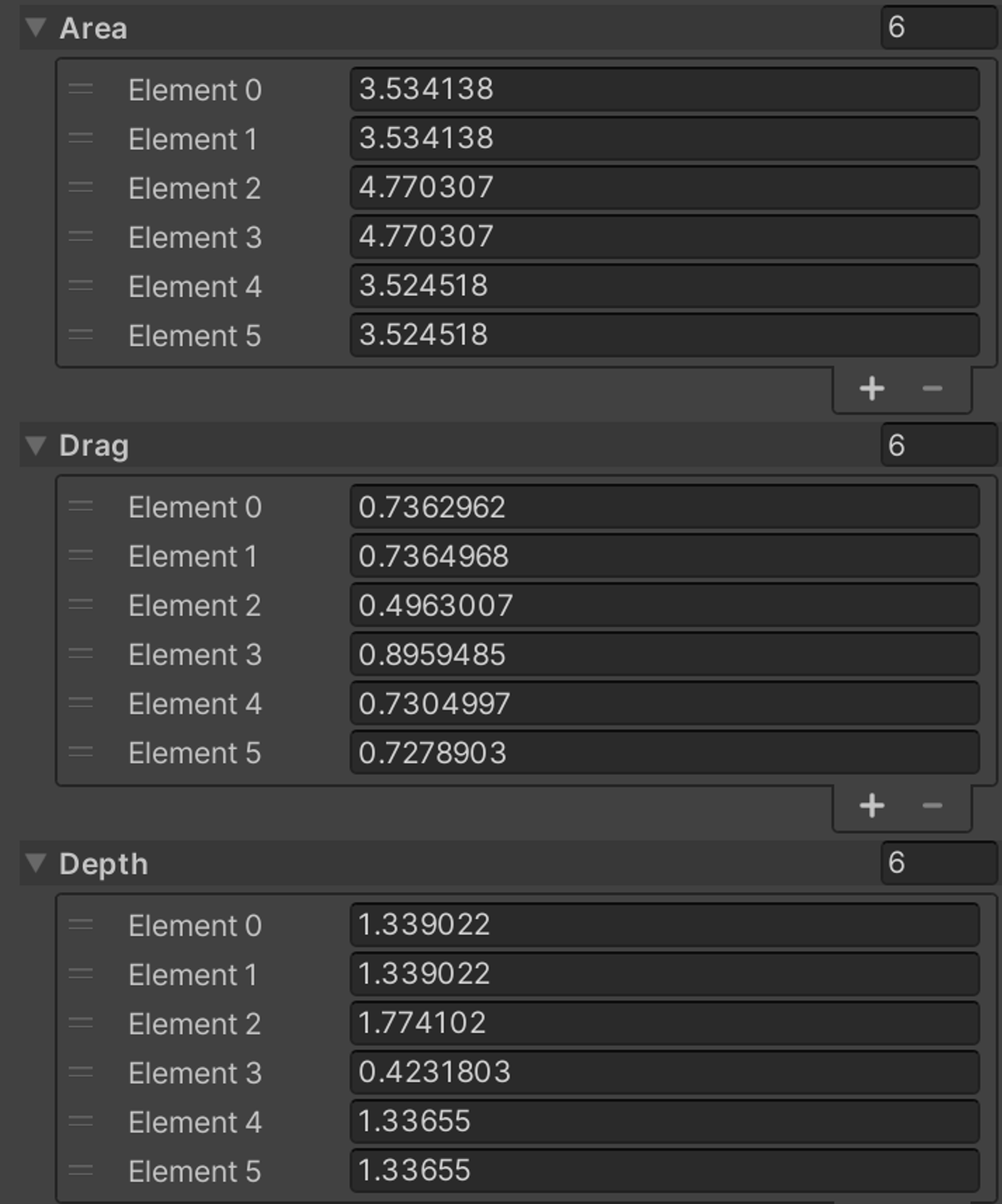 Drag cube data for the Size M conical command pod.
Drag cube data for the Size M conical command pod.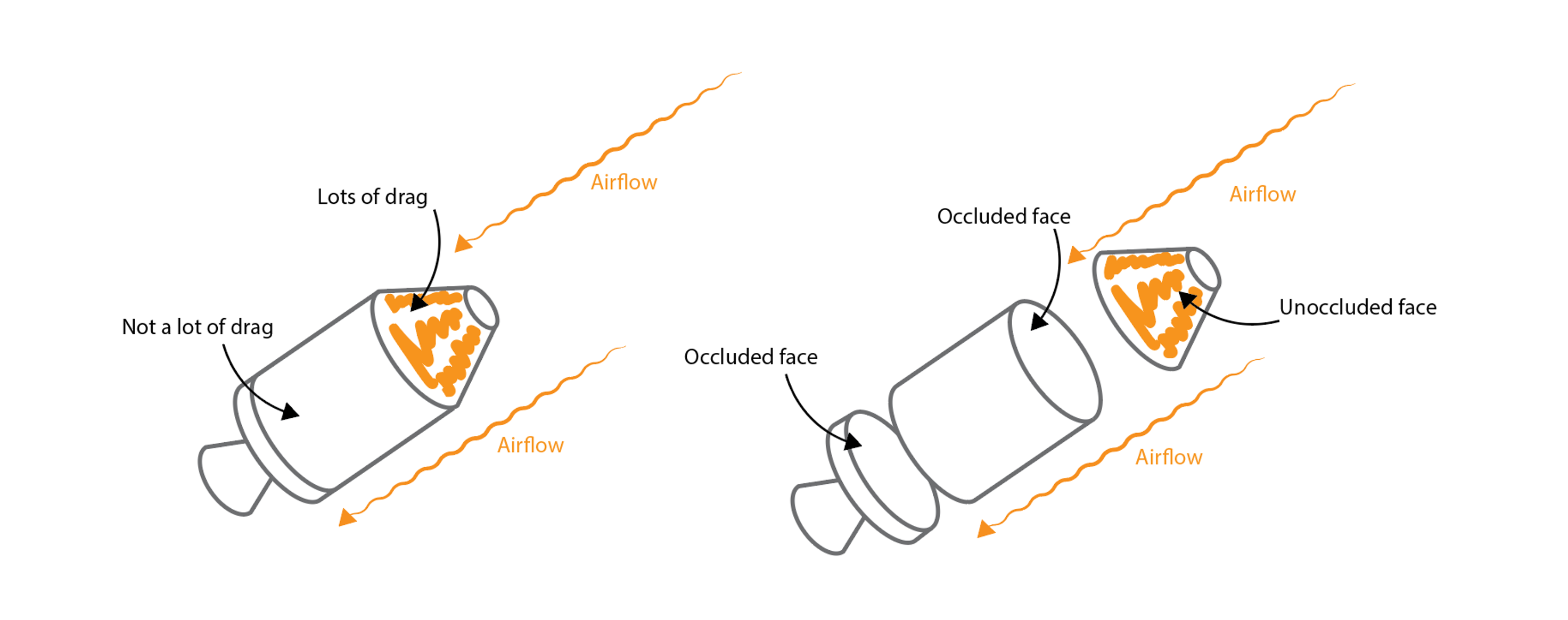 Schematic examples of how we'd expect a vessel made of 3 parts to behave with respect to the occlusion of each of its faces.
Schematic examples of how we'd expect a vessel made of 3 parts to behave with respect to the occlusion of each of its faces.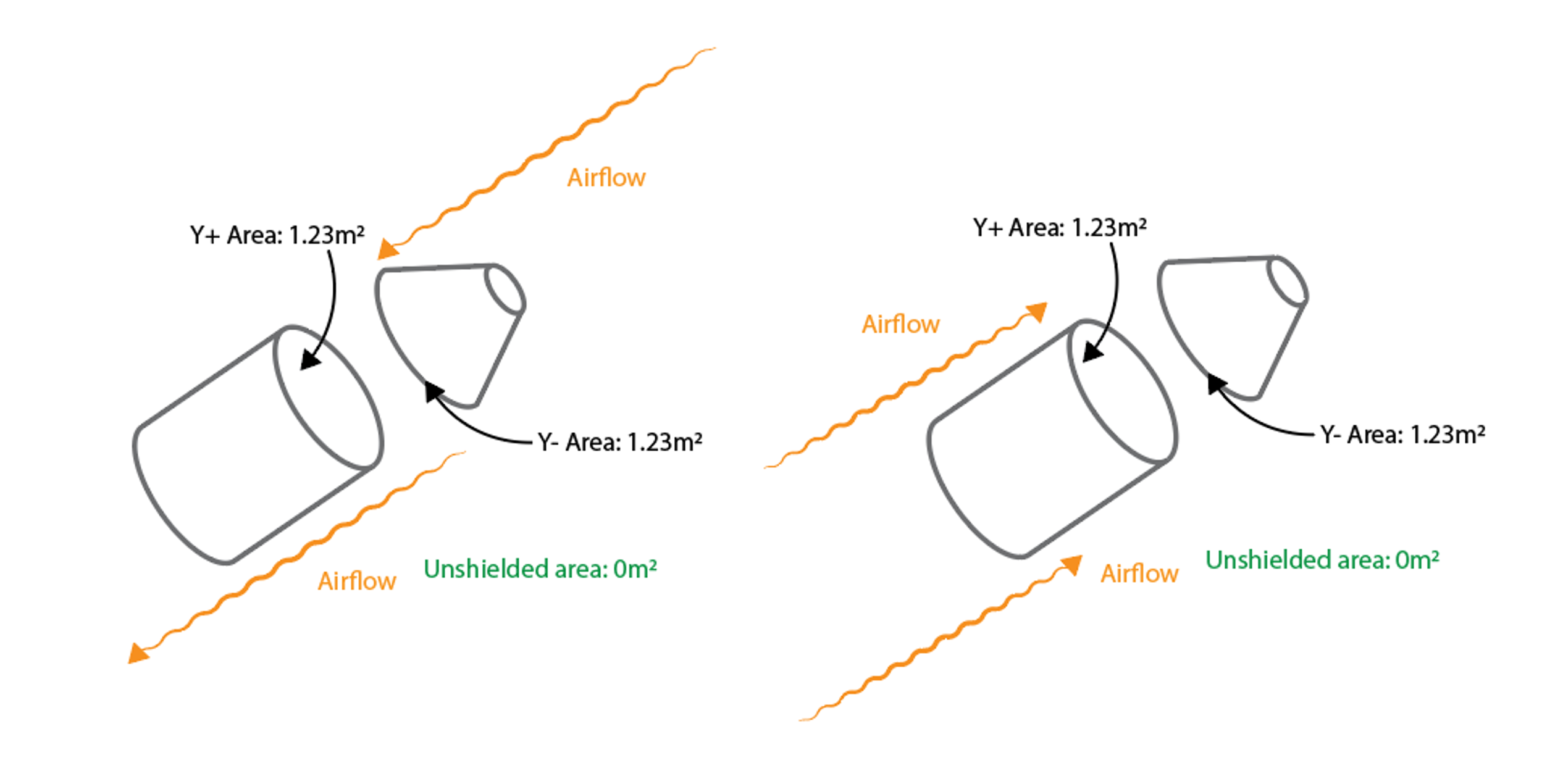 Schematic example of subtracting drag cube Y+ and Y- faces for same-size parts, in two airflow directions.
Schematic example of subtracting drag cube Y+ and Y- faces for same-size parts, in two airflow directions.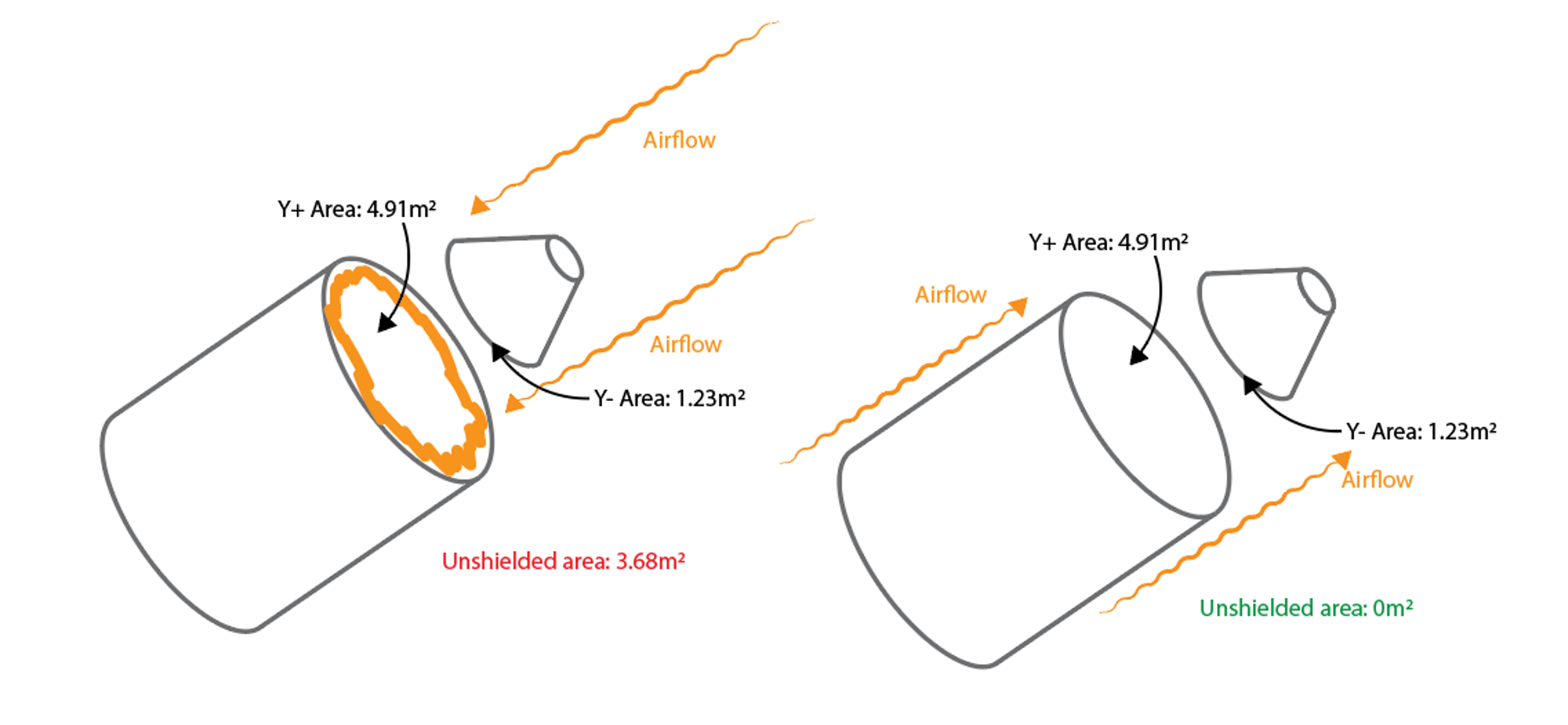 Schematic example of subtracting drag cube Y+ and Y- faces for different-size parts, in two airflow directions.
Schematic example of subtracting drag cube Y+ and Y- faces for different-size parts, in two airflow directions.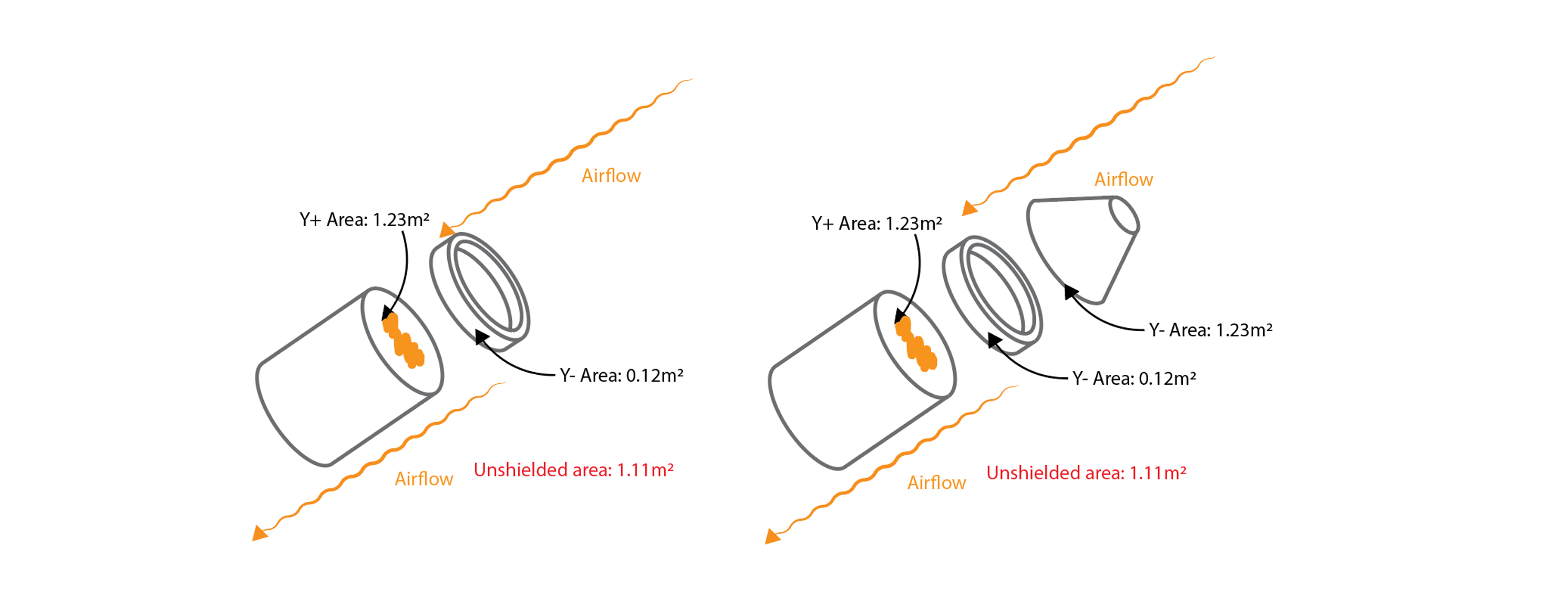 How a hollow part behaves by default in the KSP2 drag model to show how it doesn't appropriately occlude the part below it.
How a hollow part behaves by default in the KSP2 drag model to show how it doesn't appropriately occlude the part below it.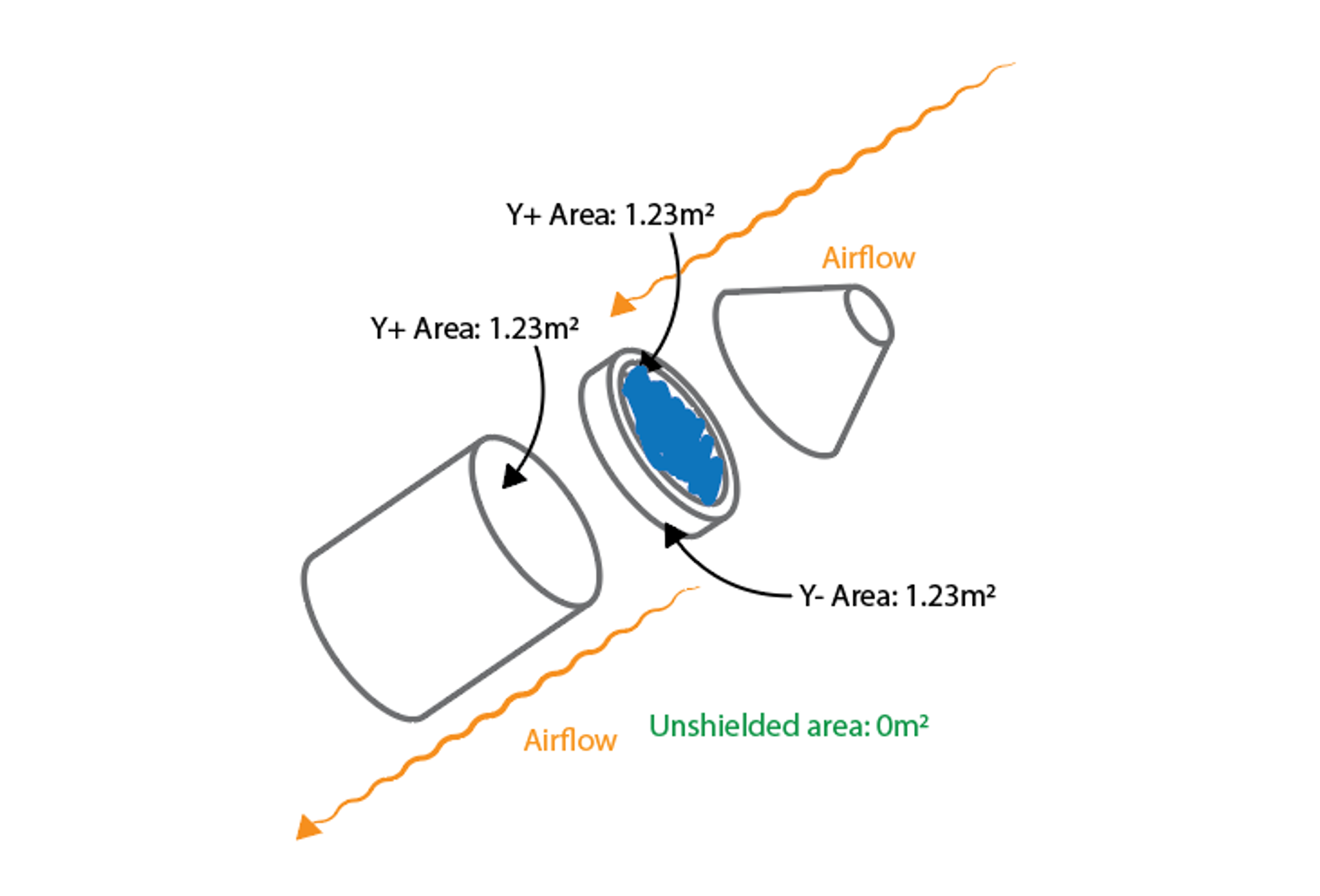 "Filling in" hollow parts to allow them to shield parts behind them.
"Filling in" hollow parts to allow them to shield parts behind them.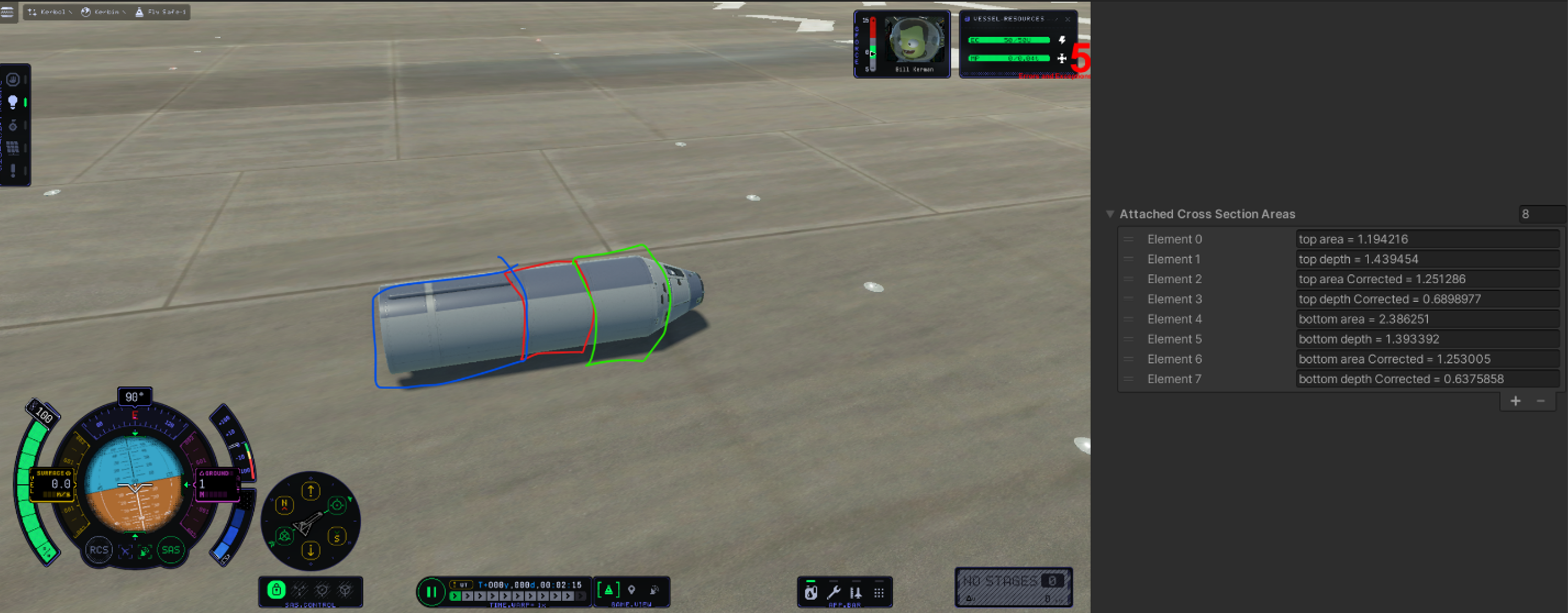 In this image you get to experience some internally famous 'Chris paint-overs', terrible MS paint scrawls trying desperately to get a point across.
In this image you get to experience some internally famous 'Chris paint-overs', terrible MS paint scrawls trying desperately to get a point across.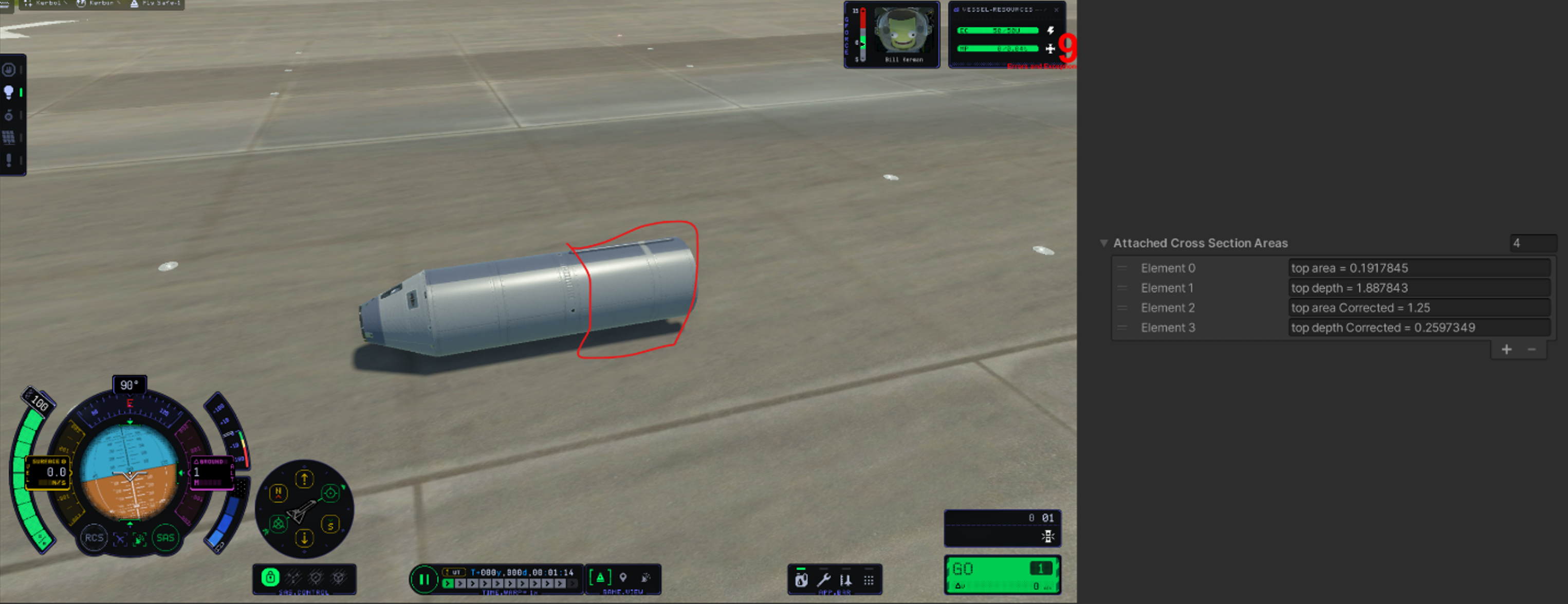 More live occlusion values.
More live occlusion values.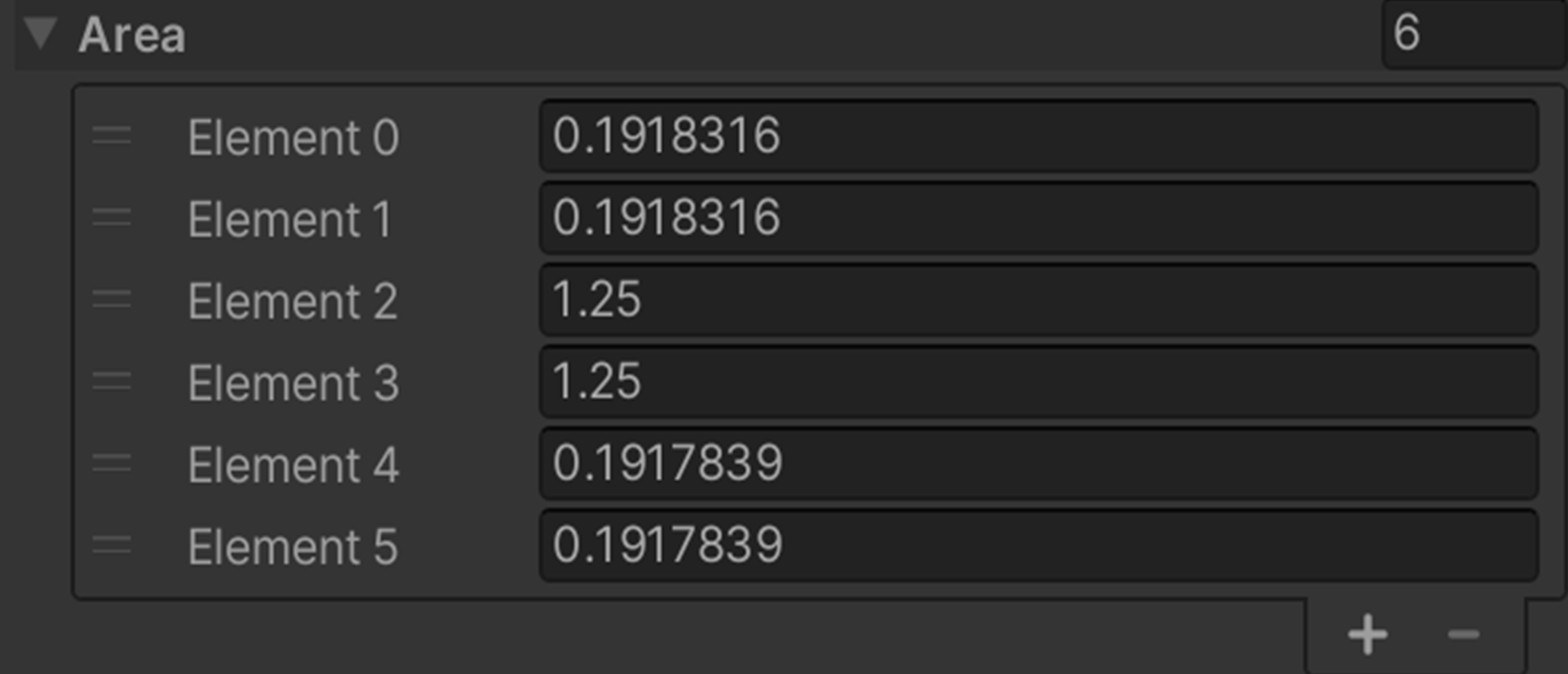 Drag Cube areas for the Size S decoupler.
Drag Cube areas for the Size S decoupler.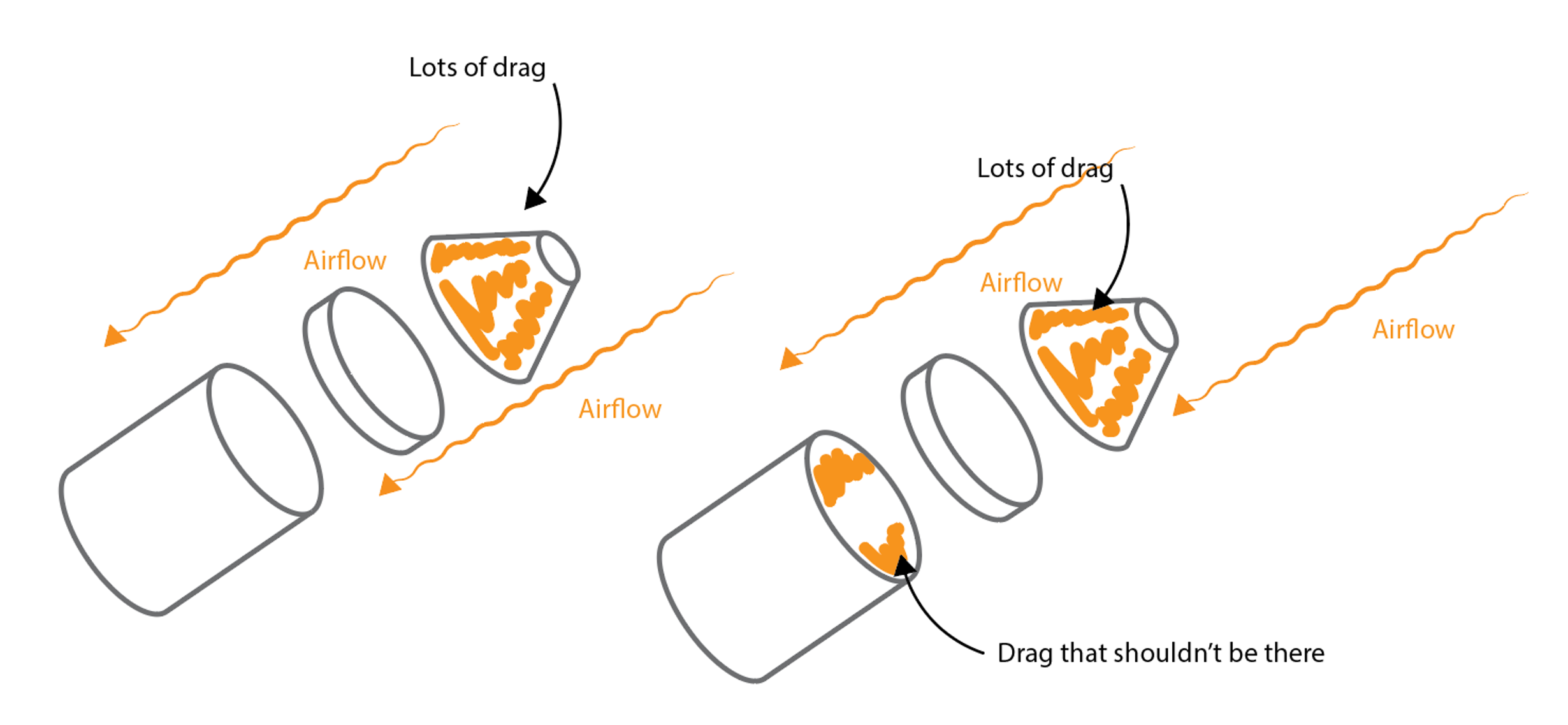 What we'd expect for post-occlusion drag (left) versus what we were getting (right).
What we'd expect for post-occlusion drag (left) versus what we were getting (right). A silly example of what we'd see (left) versus what the occlusion model would see (right). In this case you get too much drag, because there's not enough occlusion.
A silly example of what we'd see (left) versus what the occlusion model would see (right). In this case you get too much drag, because there's not enough occlusion. A second example of what we'd see (left) versus what the occlusion model would see (right). In this case you actually don't get much drag, because that Mk2 tank is occluding the Mk3 tank too much.
A second example of what we'd see (left) versus what the occlusion model would see (right). In this case you actually don't get much drag, because that Mk2 tank is occluding the Mk3 tank too much.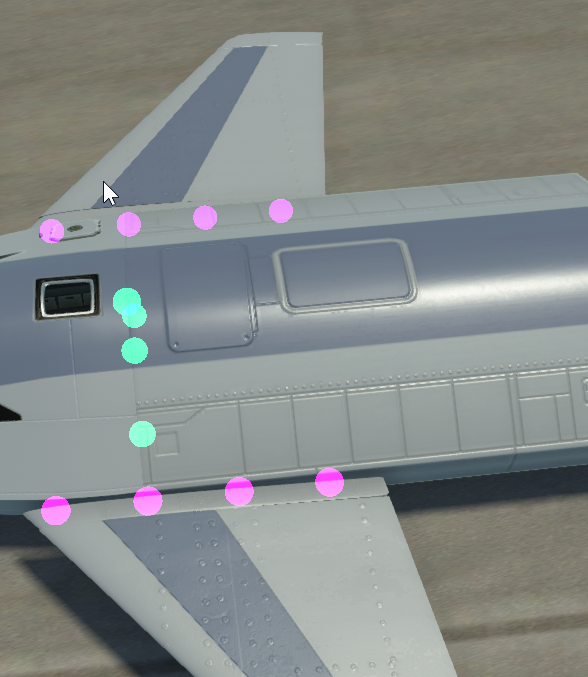
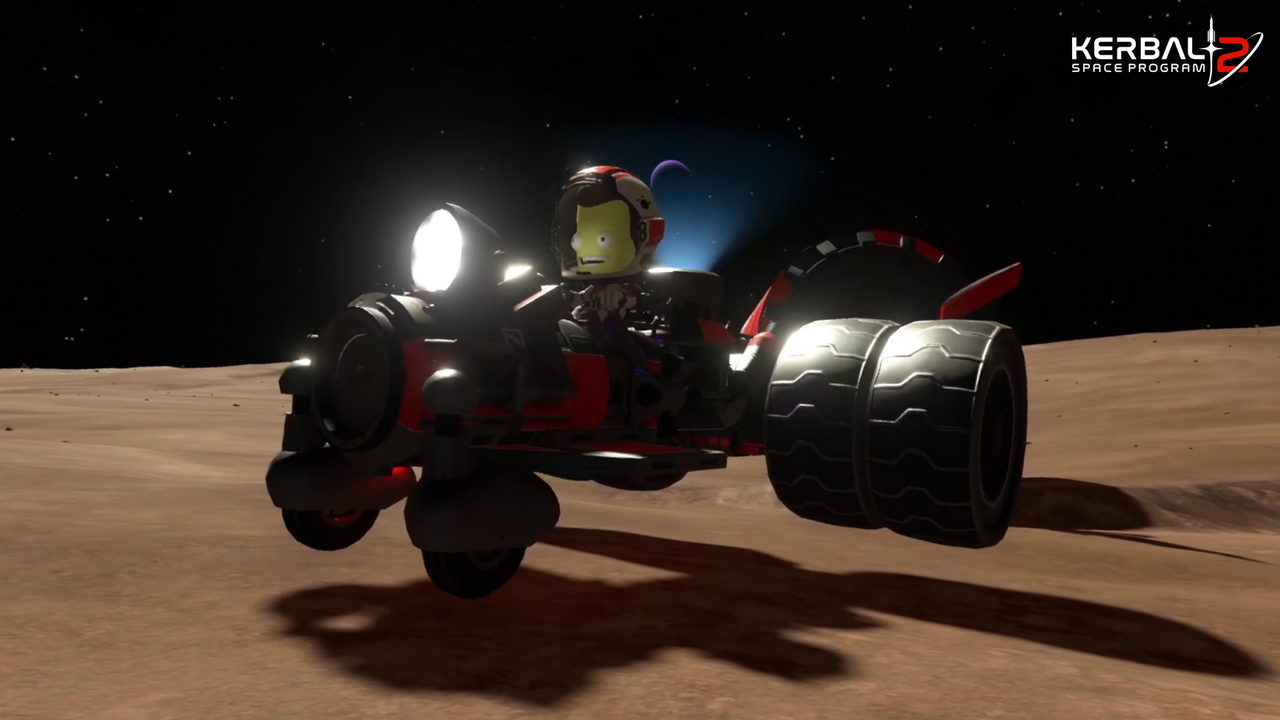
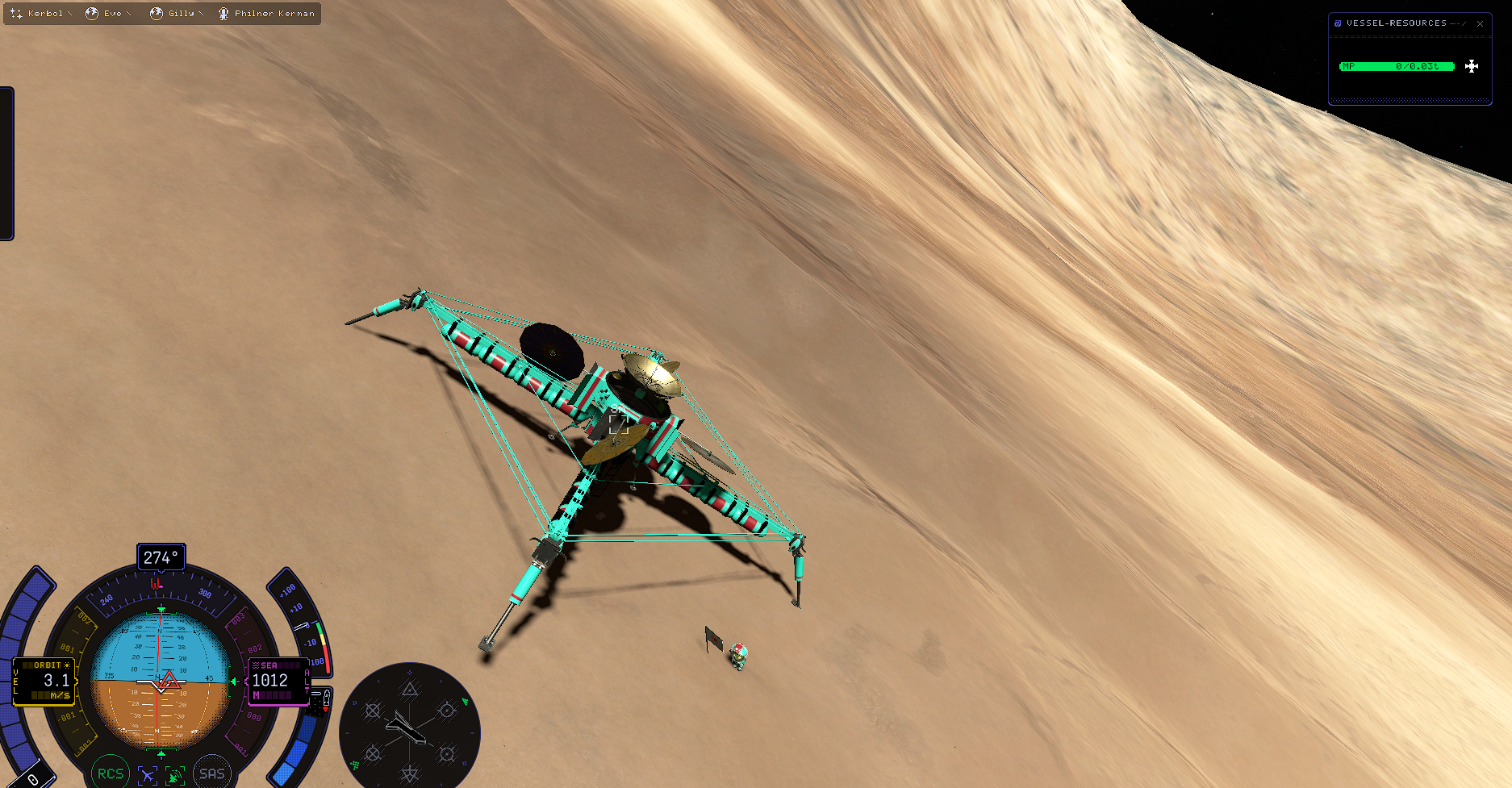
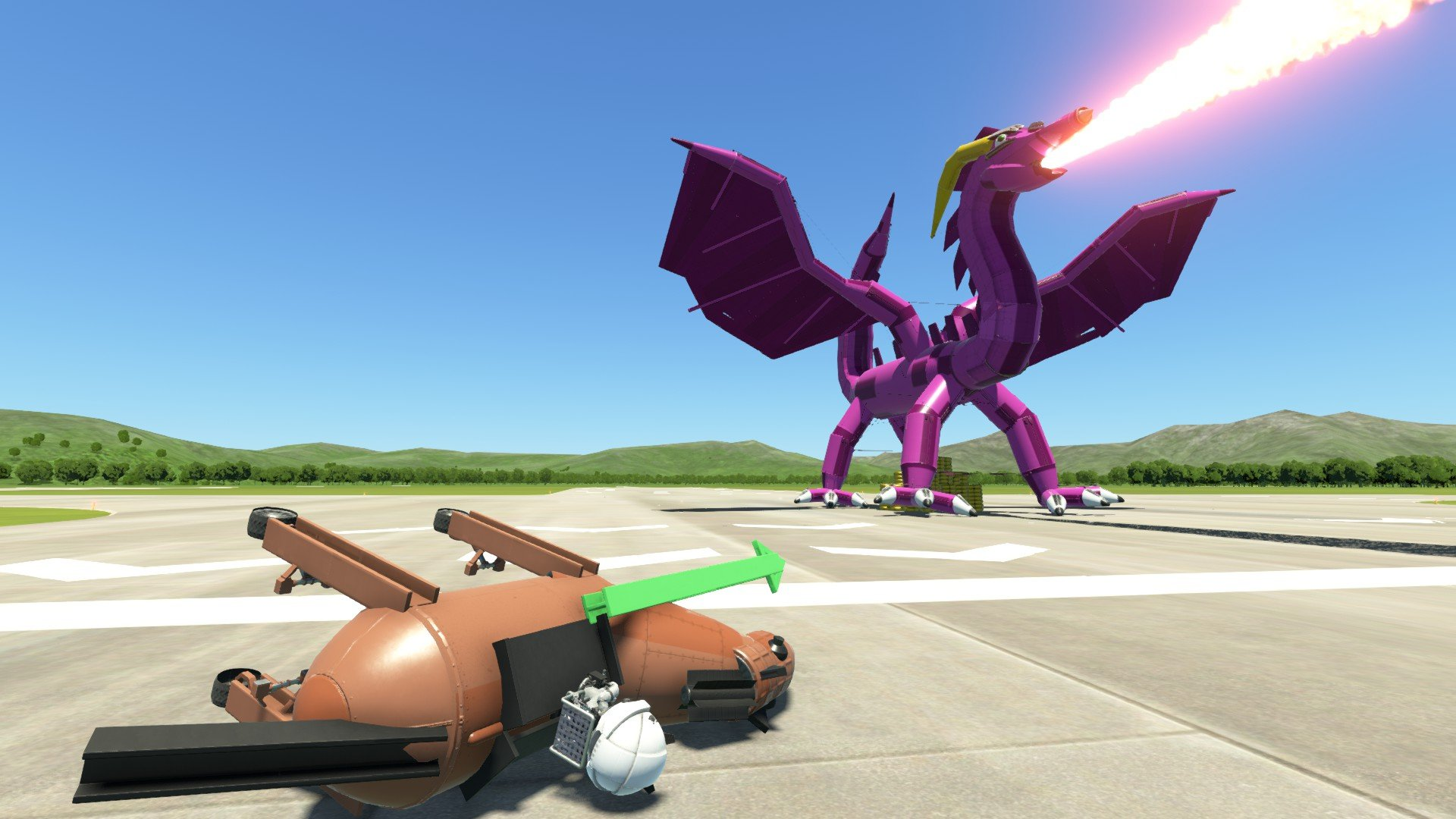 Another Coriolis masterpiece.
Another Coriolis masterpiece.